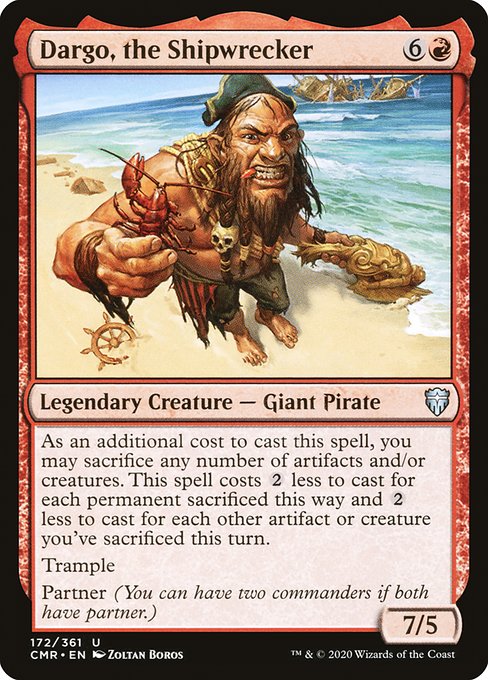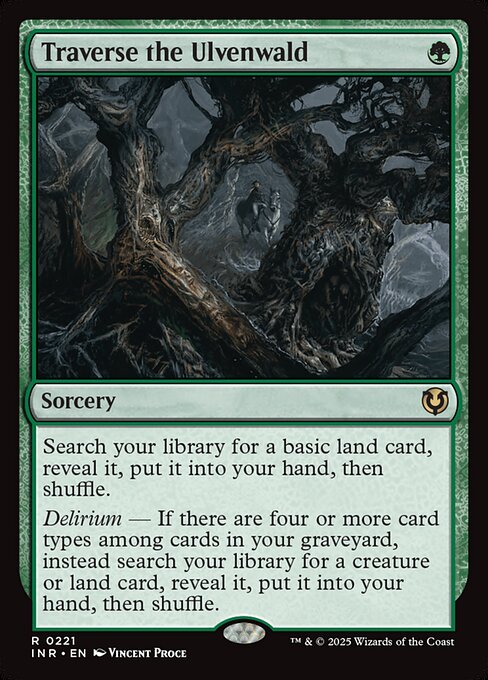A friend recently decided he wanted to start playing a new deck in cEDH. After doing some research, he concluded he was interested in Korvold, Fae-Cursed King. He looked up lists online, made a few modifications for cards he wanted to play, and played some games. After watching it, I had some thoughts.
His deck was built as a turbo deck centered on abusing Dockside Extortionist. Theoretically, you can cast Korvold quickly and then draw lots of cards and make lots of mana by abusing treasure creation. You do this primarily by making and sacrificing Dockside and reanimating it or copying it. In practice, the deck seemed extremely easy to disrupt, and Korvold mostly meant he had very few objects in play because he was frequently sacrificing lands.
I can imagine Korvold functioning as an engine for a combo deck when you’re largely goldfishing, but in practice it seems to function closer to having some card advantage in the command zone rather than being a real combo piece/massive draw engine. Worse still, sometimes you’re trying to go fast but your commander is converting board presence into cards in hand, which isn’t the best recipe for going fast. After watching it, my impression was it seemed like a worse combo commander than Dargo, the Shipwrecker.

A Big ‘Ol Pirate
Dargo offers a combo piece in the command zone. If you sacrifice enough things that Dargo costs 1, then sacrifice Dargo, for the rest of the turn, Dargo will always cost 1. If you have a Birgi, God of Storytelling or Relic of Legends or sacrifice it to Phyrexian Altar, you can infinitely sacrifice it and cast it. If this is with Birgi and another outlet, then you get infinite instances of whatever that card gives you. For example, you sacrifice Dargo to Goblin Bombardment, you get to deal infinite damage. If it’s Phyrexian Altar, you get infinite storm, as well as infinite creature entering and creature dying. So if any of those things matter, you win. I’ve seen a few different combo decks which involve abusing Dargo, and I’ve generally been impressed.
Dargo can be partnered with Ikra Shidiqi, the Usurper, or Reyhan, Last of the Abzan to play the same colors as Korvold. I don’t think it really matters much which partner you use, they each offer their own small benefits, but you’re mostly playing them for their color identity.

By playing Jund you get access to a lot of great tutors, fast mana, and ways to protect yourself from blue cards with Veils and Blasts. You can use cards like Birthing Pod and Eldritch Evolution to turn Dargo into Razaketh, the Foulblooded and you can play great sacrifice outlets like Greater Good and Goblin Bombardment.
Gwenna, Eyes of Gaea is another way to generate mana to infinitely cast Dargo. If you want, you can also use Runaway Steam-Kin as a bad Birgi, but I think it’s not worth it.
If you try to win with a Dargo storm turn and get stopped, you’ll never be able to cast Dargo again unless you make infinite mana. As a backup, I’m playing Acererak the Archlich. With Acererak the Archlich and Gwenna, Eyes of Gaea, and either Birgi, God of Storytelling or Relic of Legends I can infinitely venture into the dungeon to win the game. It’s possible that I should be playing Heartless Summoning as an alternative to Gwenna, but I don’t think it’s worth it for a backup combo.
Instead of cards like Altar of the Brood or Impact Tremors I’m playing Grapeshot and Tendrils of Agony to win after a Dargo Storm turn. It’s not clear to me exactly how many of these payoff cards you want.
The Key Pieces
I’m not really trying to get into a full primer here. I think the deck’s pretty cool, but I haven’t played it, just made a list based on theory. My list is here.
My point is about making sure you’re playing the right commander for your strategy and the right strategy for your commander. I suspect, though admittedly, having played neither, my confidence isn’t that high, that Dargo is a better commander for a turbo combo Jund deck than Korvold. But that doesn’t mean Korvold is a strictly worse deck, rather I think it should take a different approach.
I think it wants to be a midrange value deck, which is a dangerous space to operate in cEDH, especially without blue, but I think it’s possible. This deck’s different philosophically than most cEDH decks I’ve seen, so let’s go over it in a bit more detail.
Korvold is expensive and ultimately converts mana into extra cards, so the deck has a lot of mana:
- Birds of Paradise
- Deathrite Shaman
- Delighted Halfling
- Gilded Goose
- Ignoble Hierarch
- Orcish Lumberjack
- Ragavan, Nimble Pilferer
- Tinder Wall
- Dockside Extortionist
- Chrome Mox
- Jeweled Lotus
- Lion’s Eye Diamond
- Lotus Petal
- Mana Crypt
- Mox Diamond
- Mox Opal
- Mana Vault
- Sol Ring
- Grim Monolith
- Noble’s Purse
- Carpet of Flowers
- Crop Rotation
That’s 22 cards whose primary purpose is to make mana, in addition to Generous Ent (another way to fix while getting a forest for Orcish Lumberjack) and 28 lands, so a little over half the deck is mana.

From there, it’s essential that this deck does something as soon as possible to disrupt combo decks, since it’s not trying to be the fastest deck. Since it can’t interact on the stack easily, instead, it relies on stax pieces to pull opponents into a fair game.
- Damping Sphere
- Sphere of Resistance
- Thorn of Amethyst
- Trinisphere
- Dauthi Voidwalker
- Opposition Agent
- Manglehorn
It’s a bit light, but these are most of the tools available that I think are actually effective. I suspect that this deck wants to tutor fairly aggressively for Damping Sphere.

From there, the deck is mostly just looking to generate material advantage, mostly in the form of tokens that Korvold can convert into more cards.
- Goblin Welder
- Goblin Engineer
- Orcish Bowmasters
- Academy Manufactor
- Chatterfang, Squirrel General
- Eternal Witness
- Experimental Confectioner
- Peregrin Took
- Tireless Provisioner
- Tireless Tracker
- Grim Hireling
- Pitiless Plunderer
- Ruthless Technomancer
- Saw in Half
- Mishra’s Bauble
- Urza’s Bauble
- Spiteful Banditry
- Black Market Connections
- Fable of the Mirror-Breaker
These cards play good fair magic–they don’t require much investment and they mostly generate immediate value. Independently, they’re not too threatening, so opponents will mostly want to ignore them, but these cards are also what the deck does–you play creatures that are generally useful in the context of the deck but that include incidental infinite combos, like Peregrin Took+Experimental Confectioner, Chatterfang, Squirrel General+Pitiless Plunderer, and Ruthless Technomancer+Dockside Extortionist.

You have a few other payoffs to win the game:
As with most decks I build, this deck is very high redundancy and low exposure–it’s never devastating if the opponent answers a single card.
Of course, it has some interaction:
And a lot of tutors:
- Gamble
- Traverse the Ulvenwald
- Demonic Tutor
- Diabolic Tutor
- Finale of Devatation
- Eldritch Evolution
- Entomb
- Vampiric Tutor
- Invasion of Ikoria
And a couple other good cards:
While building this deck, I went pretty far off the deep end and had to reel myself in. There’s always a tricky balance in building cEDH decks to strike between good cards (generically strong cards in your colors that every cEDH deck should consider) and bad cards (synergy cards that only make sense in the context of your particular deck). It’s easy to end up in a space where several bad cards justify some even worse cards and you have to dial it back in. I suppose you could not, and you could play the worse cards instead of the good cards and then you’d be building a casual EDH deck. I’ve left evidence of this process in the Considering section of my list.

If you like the idea of this deck, but you’d rather play a more extreme version that plays more sweet cards and fewer competitive necessities like the stax pieces, I think there’s a pretty good map for a somewhat high power casual deck available there.
I built both my take on Dargo Jund and Korvold just to make a point about what I thought my friend should do with his deck. But I kind of want to try playing this–it strikes me as fairly similar to Tayam, which I’ve found to be pretty strong. Both decks are more resilient than fast, don’t interact with the stack, but have a few ways of making things harder for the opponent. I think this deck is actually a bit more disruptive, which I like.
Sam Black (any) is a former professional Magic player, longtime Magic writer, host of the Drafting Archetypes podcast, and Twitch streamer. Sam is also a Commander Cube enthusiast, and you can find Sam’s cube list here. For anything else, find Sam on Twitter: @SamuelHBlack.

